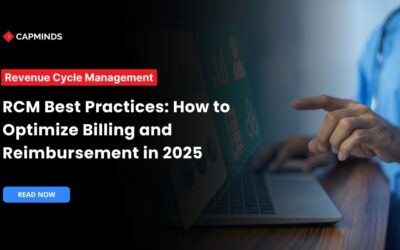6 Hospital Charge Capture Best Practices
In today’s current scenario, it is becoming very difficult for healthcare practices to maintain practice revenue. RCM is becoming more complicated over the years with the advancement of digital technologies like remote patient monitoring and value-based reimbursement models. With so many changes and challenges in today’s health system, medical practices can’t afford to ignore the charge capture process. Here, CapMinds listed the 6 best practices for the charge capture process.
Optimize with Technology
There are simple methods to capture clinical data and transfer that information to a medical biller to properly code the diagnoses and procedures, and get the information submitted to the right insurance companies. Leveraging technology, and eliminating paper, will immediately create greater efficiencies and set up your organization for related tracking and auditing procedures. Plus, with technology, you can more consistently modify and update charges when needed (and importantly create a defensible audit trail), which will clear uncertainty.
Educate to Overcome Adoption Issues
As with any system, if all the stakeholders involved in the process (from the clinician delivering care to medical assistants or scribes capturing data to administrators involved in capturing demographic and insurance data) don’t fully understand the charge capture process and the critical importance of each step in that process, there will problems.
Staff needs to be educated on why charge capture matters because without a consistent process, insurance claims won’t go out in a timing matter, may under or over capture the services delivered, or simply will result in the team not getting paid.
Staff mustn’t wait on officially coding procedures as this could cause even more problems. For example, the contract with the insurance company may stipulate that if new charges are not submitted in a timely matter or corrections to denied charges are not addressed within the proscribed timeframe, then the hospital may lose out on that revenue. There are frequent changes in coverage so providers need to understand the importance of following the rules closely.
Document the Process
Hospitals are most successful with their charge capture process not only when it’s well-communicated and all stakeholders are educated, but the process must be well-documented. Further, having central charging policies and guidelines established and documented will remove room for error and improve consistency as new team members join the team and pick up where others leave off.
Charge capture is not always a one-and-done process, instead, think of it as the bi-directional flow of information among many constituents. A well-documented charge capture process ensures that all providers are following the same process. Also, when new clinicians come on board, the documentation can be provided as part of their onboarding process.
Use Tech to Catch Pre- and Post-Billing Exceptions
Using a technology platform to catch exceptions will remove some headaches. The hospital can then use this data to find anomalies and exceptions so that correct codes can be added or selected the first time around, getting billing moving through the process — instead of stuck in purgatory.
Audit the Process Regularly
One of the fundamental activities a hospital must do with charge capture is audited their billing regularly. This will ensure that the correct charges for each patient were submitted. Not only should standard billing be audited, but it’s also a good idea to look at services that have both a technical and professional aspect — like radiology — to check that both codes were inputted into the system.
Examine Lag Time Challenges
Charge lag was number two on the challenges list and it continues to be a problem. However, it can be remedied. Hospitals can look at the lag time between all major steps in the process such as from the date of service to the date of claim submission to the date the claim remittance advice was received to the date the claim was finally paid and try to determine where bottlenecks arise.
That information can be used to compare their times to industry benchmarks, which will let them know understand charge their lag and what area of the process needs improvement or intervention by management. By going deep into the data, and also considering what the process currently is, professionals should be able to find ways to shorten time delays.
Why go with CapMinds RCM Services?
Charge capture is important in a hospital’s revenue growth. Choosing the right RCM partner will help you to achieve successful results in terms of medical billing collections. Get started with CapMinds RCM services for a successful charge capture process – our RCM experts are available 24/7 by helping practices to overcome the challenges with charge capture quickly and in improving your overall practice revenue.





